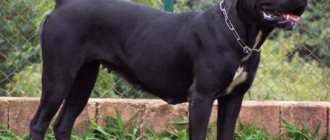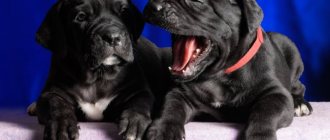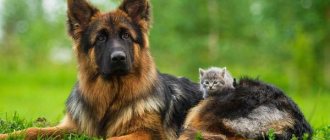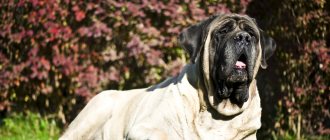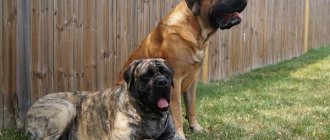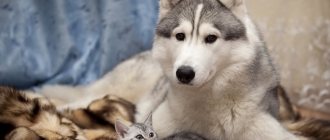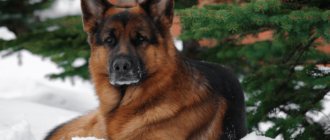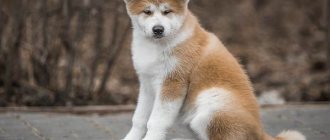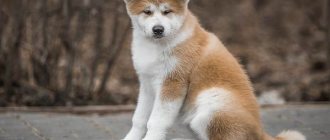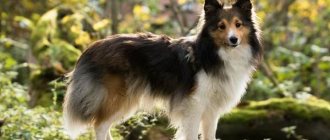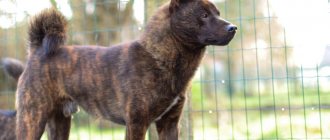The Cane Corso is a dog breed that is officially registered recently, but is actually one of the oldest. Presumably it came from dogs used in gladiator fights, but this did not affect their character. The Cane Corso has long served people: guarding property, protecting it, helping in the field and hunting. This is a fairly large dog, with a menacing and impressive appearance. In the 21st century, it has become a popular pet. This is explained by the unusual good nature and devotion of the representatives of the breed, as well as unpretentiousness and ease of care. But before you get a Cane Corso puppy, you need to study the characteristics of these dogs, their advantages and disadvantages.
- Head
- Education and training of the Cane Corso
- Health
Description and features
The homeland of the Cane Corso breed is Italy. The ancestors of its representatives were strong dogs with pronounced guarding qualities. They were distinguished by their stable psyche and ability to quickly make decisions in extreme situations. Such skills are also inherent in modern dogs of this breed.
Combat service has always been their basic purpose. Animals were exploited mainly in the arena. From childhood they were trained against each other to train anger and intolerance. These four-legged giants were also used for guard duty.
They quickly reacted to the approach of new people to the owner’s home; more often than not, they did not let them in. It was almost impossible to persuade such a dog to compromise. He is distinguished by his willfulness and courage, so he treats all strangers with distrust, and especially those who want to cross the territory he protects.
The Cane Corso is an intelligent and fearless dog breed.
But that's not all. Also, representatives of the breed were and remain talented hunters. They went with them into the forest and mountains to catch large animals. They were able to defeat even a wolf. People always knew that as long as a Cane Corso was nearby, nothing bad would happen to them. The dog is always ready to protect the owner and his family members. He is not only a fierce hunter and fighter, but also a reliable protector, a good companion and a wonderful friend.
Like any four-legged pet, such a dog is capable of affection, compassion and friendliness. He cares about the emotions of his family members. The dog is incredibly responsive. Her priority has always been and will be to ensure the safety of her family, but this does not mean that she patrols the territory around the clock in search of intruders.
Yes, the representative of the breed is very vigilant, but in his “free time” he is ready to play and have fun. Quite restrained in terms of showing emotions, not intrusive, balanced, but sometimes gentle and affectionate.
This dog has an excellent set of working qualities. This could not but remain in the field of view of law enforcement officials. He began to be used as a service dog by customs and the police. The dog's sense of smell is excellent. He copes well with the search task.
Interesting fact! In some European countries, keeping such a pet at home is considered prestigious. People use it to protect not only their homes, but also shops, boutiques and even supermarkets.
These are quite temperamental animals, which nevertheless get along well with people of different ages and genders. They enjoy a welcoming family atmosphere.
Breed standard
The Cane Corso dog is large, tall and powerful. Males grow up to 70 cm in height, and females – up to 67 cm. The former weigh about 50 kg, and the latter – 45 kg. In each of these parameters, a slight deviation is acceptable. The individual, regardless of gender, has a powerful body along which lean muscles run. They have a thick neck of medium length, well-defined withers, and a strong skeleton.
The chest is well developed. The volume is wide. The tail is located high, according to the standard it is docked at about 2 months. The stomach is not sunken, the back is powerful and strong. The dog's legs are long and muscular. Thanks to this, she runs fast. Her movements are sweeping.
The Cane Corso is a large dog with pronounced muscles.
The head of the animal is massive, the skull is oblong. The forehead is convex. At the tip of the muzzle there is a large dark nose, the lips are thick and drooping. Sometimes they become excessively wet, hence the mouth drooling. The Cane Corso in the photo looks strong and confident. This is partly due to his expressive large eyes.
According to the standard, they must be painted black. A light iris is considered a huge defect. A dog's ears are cropped during childhood. They should stand in a slightly turned position. The fur of these animals is short and shiny. There is undercoat, but it is very sparse. An individual is considered low-breed if its coat:
- Longer than 1 cm.
- Curly.
- Wavy.
- Doesn't shine.
Acceptable colors:
- Brindle.
- Silver.
- Pure black.
Kinds
The Cane Corso is standardized as a single breed. Nevertheless, breeders continue experiments to develop new types of dogs. Thanks to them, the following mixed breeds of the dog in question appeared: Great Dane, Mastiff, Boxer and several additional types - Bullmastiff and Staffordshire Terrier.
Each of them is a distinctive and unique type of breed. They differ in size, body parameters and some character traits. For example, the Bullmastiff is the most muscular Cane Corso mix.
Its power cannot but amaze. The mestizos closest to the “original” is the mastiff. This dog is practically no different from a standardized Cane Corso. He is just as tall, strong and working in terms of hunting and protection.
Pet health
The health of the Italian Mastiff largely depends on genetic background.
One of the most common problems is femoral dysplasia, which develops in the hip sector of the canine skeleton..
Even in a mild form, the disease leads to lameness, and in severe cases, loss of motor ability is possible.
The pathology is very difficult to control and treat. The most effective way is to prevent the appearance of new offspring with this problem.
Dog owners conduct x-rays of the joint before the first mating . When it is detected, measures are taken to limit the birth rate.
Character
Some people are downright intimidated by a huge, muscular dog with a loud bark, while others, on the contrary, are fascinated by it. The Cane Corso is not just an efficient dog with typical guarding qualities, he is also a good-natured and gentle pet, ready to cheer up an owner who needs consolation. In addition, he is incredibly smart and intelligent.
The interesting thing is that he does not need to be trained as a guard at all. The dog senses which people should be under its protection. She is also ready to guard an apartment, house or plot of land belonging to its owner. Very responsible and observant.
If she sees that a person wants to cross the territory she protects, she gets angry, barks loudly in order to scare him away, and at the last stage she prepares for an attack. Do not overestimate the fighting potential of such a dog. Yes, he is naturally strong and powerful, but he does not seek to inflict serious physical damage on a person, especially a stranger. Rather, he will knock him down and immobilize him.
However, you shouldn’t tempt fate once again and watch how the animal behaves with one or another of your friends. Do not forget about the presence in his character of distrust of strangers. He perceives any stranger as a potential threat to his family.
However, he is characterized by adequacy and balance. He never retreats, even in front of a very strong opponent, and strives to control any situation. Well brought up, relies on the owner with respect for him. Endowed with leadership qualities.
The Cane Corso becomes very attached to its owner and tries in every possible way to please him.
Prefers to patronize weaker creatures. It is extremely rare to start quarrels with other animals, even with cats. He strives to establish friendly relations with them, even if they are not very happy about it.
Note! The Cane Corso gets along well with small dogs, such as the Yorkshire Terrier.
Parents of small children, who are also owners of such pets, can spend hours watching their touching interactions. Large dogs are good nannies. They are responsive and very responsible. They like it when babies are physically dependent on them. They can lick them for a long time and carefully remove them from others with their huge paw.
These dogs are quick-witted. It’s enough to point them to the place a couple of times and they’ll remember it forever. Loyalty to a specific person lasts a lifetime. She will never leave him in trouble. However, Cane Corso puppies are quite shy. Due to extreme stress, they can hide in a corner and start whining. To raise them to be fearless and self-confident, you should not be too obsessive about caring at this moment.
Care and maintenance
Let's start with the main thing - the Cane Corso is completely unsuitable for apartment keeping. He will be comfortable on the street, where he can regularly be in the fresh air and protect the area. Huge dogs must always be on the move, otherwise they begin to feel sad and sick.
There is no need to chain a representative of the breed, but periodically locking him in an enclosure is required. Always do this when the postman, repairman, courier, or anyone else comes to your home. Remember, such a pet should not interact with your guests. He needs to be isolated from them. In the enclosure, the dog must have bowls for water and food, toys and a soft bed.
If you decide to equip him with a booth, then it is not necessary to provide an additional sleeping place. These dogs shed all year round. Their undercoat, which is periodically renewed, looks like tiny needles. It is extremely unpleasant if it gets on clothes or food, which is why we recommend systematically combing them out with a comb or brush.
Don't forget about the Cane Corso's drooling. A huge amount of thick liquid is released from its mouth, especially when eating or drinking. We recommend wiping your dog's face with a cloth after he eats or drinks. This will help prevent her saliva from getting on people, household items, or furniture.
Advice! You should not go for a walk with such a dog immediately after he has eaten. Give him a chance to digest his food.
Some tips for caring for your Cane Corso:
- Comb his fur all over his body, not just in certain areas.
- Trim his nails once a month unless he sharpens them himself.
- Wash his face to clear it of saliva, tears, and food debris.
- Brush his teeth to prevent plaque from destroying the enamel on their surface.
Cane Corso will never attack without the owner's command
Regarding walking. It is advisable to take a large pet outside every day, even if he lives in a house and not in an apartment. While the dog is walking, it spends the energy reserve that it accumulates during the day, after which it rests well.
Puppies
Cane Corse puppies are very expensive, and at first glance it may seem that their maintenance also requires fabulous money. In reality, this requires the same amount of money as keeping a Rottweiler, German Shepherd, Boxer or large mongrel dog.
From the first day the little “Italian” appears in the house, he needs attentive attention:
- A place for the puppy to rest is equipped in a part of the house or apartment where there are no drafts, close proximity to heating devices and high traffic. The presence of an elastic mattress (preferably with a removable cover to maintain cleanliness) is mandatory, let it be larger than the size of the puppy, because the pet will very quickly increase in size.
- The puppy is prohibited from walking on stairs or jumping over obstacles, as this can lead to improper development of the still immature musculoskeletal system. To avoid the same problems, the puppy is not picked up by the chest or front legs, but with one hand under the chest and the other under the stomach.
- Cane Corse, whose puppies do not yet have immunity, should not be taken out for walks from the first days. The optimal time for the first walk is the third week after the 2nd vaccination.
- If you go out with the puppy after feeding or sleeping, she will gradually learn to do her “toilet” chores outside.
- The age of 1.5-2 months is the right time to start accustoming to a nickname and collar. We do not recommend putting the collar over the ears, or stroking the head and ears, as this can cause the ears to be positioned incorrectly.
The fear of owning a Cane Corse is due to the relative youth of the breed. Dogs were first brought into Russia only in 1994. Very often, the fears of future Italian owners are not justified, since their puppies are easy to train. The Corso is even called a “dog for amateurs”; with a serious approach, even a person who is dealing with dogs for the first time can raise and train it.
If you instill good habits in your puppy from the first days and raise it correctly, you can get an adequate protector, a loyal friend, an uncompromising guard who will be the pride of the owner not only due to his presentable appearance and excellent character.
Nutrition
The Cane Corso eats quite a lot, as he is large and energetic, so he needs a lot of calories, which his body will convert into energy. For a dog to be healthy and strong, he needs a balanced diet, the basis of which should be proteins.
A puppy of a large breed of dog should eat raw meat, cottage cheese, boiled buckwheat porridge, stewed vegetables and soup daily. Meals should be varied. Meals should be organized at the same time of day and evening. This will allow the dog’s young body to function better.
It recommends feeding adult dogs a ready-made diet and vitamins. It is advisable to purchase dry food for them, 30 kg per bag. Preference should be given to a premium or super-premium product, as it is considered to be the most useful. We recommend using vegetables, fruits and bone meal as vitamin supplements.
Walks with your Cane Corso should be active, with games and running.
When is the help of a dog handler needed?
A professional dog handler should be contacted if the pet’s behavior needs to be adjusted, for example, if the dog is too aggressive and the owners cannot cope with it. Also, the help of a trainer may be required if the pet refuses to exercise at home or manipulates the owners.
If during the process of home training a Cane Corso, difficulties arise that the owners cannot deal with, they need to contact a dog trainer.
Reproduction and lifespan
Large dogs are bred as well as medium and small ones. The rules are standard. Let's list them:
- Adult dogs over 1.5 years old are selected.
- They must be calm, adequate in all respects, not eccentric.
- They must not be blood relatives to each other.
- There are individuals on the territory of the male or in a neutral place.
The breeder must know how to distinguish a high-breed Cane Corso from a mixed breed. The female bears puppies for about 65 days. While they are growing up, you should not get too close to them. Healthy representatives of the breed live for about 12 years.
Price
There are few purebred Cane Corsos in Russia. Most private breeders offer mestizos, which are passed off as purebred representatives of the breed. Therefore, before purchasing, we advise you to familiarize yourself with the documents for the animal, especially in detail you should study its veterinary passport. Ask the seller if he vaccinated the puppy, in which clinic this happened, what exactly was injected, etc.
If he cannot give you intelligible answers to questions regarding the dog’s health, you should not rush to buy it. So you risk getting a pig in a poke. It is better to trust professional breeders who will definitely offer you a purebred and beautiful pet. The price of a Cane Corso with a pedigree is from 25 to 35 thousand rubles.
Origin story
The history is vast, because these are truly the descendants of gladiator dogs. There is a version that the first representatives of the breed appeared in the first millennium BC. They accompanied rulers on military campaigns.
After World War II, the breed almost disappeared from the face of the earth. But the Italian biologist Nizzoli took up her emergency rescue and made enormous efforts to reproduce them. The current standard was formed much later - in the 90s.
Photo: instagram.com
Education and training
For a fighting dog, the owner becomes a person who trains it regularly. It is for him that she gains respect and learns to serve. The representative of the breed is prone to learning; he does not seek to avoid training, as he is curious about everything new, especially the training process.
It is extremely important to start building a hierarchical relationship with him early. The Cane Corso is a serious and large dog that will only become disciplined if it has a strong owner-leader. She must learn to obey from an early age, preferably at 3 months. Therefore, we advise you to take care of the animal while it is socialized in your home.
For example, accompany him while he explores the territory of the house; you can first attach a leash to his collar. Control your pet's movements, prohibit him from jumping over the fence or digging near it. To satisfy your pet's thirst for new knowledge, go for walks with him every day.
Don't forget about physical activity. Such a strong dog needs to be literally exhausted so that it loses the energy accumulated during the day. The simplest option is to throw a stick into the distance and ask her to bring it. But you can let your Cane Corso off the leash only after he learns to calmly walk next to you and not be distracted by anyone.
It is very important to teach such a dog to adequately greet guests. He should not react to them in any way if his owner is nearby. Invite him to sniff the guest and sit next to him. Control your pet's mood. If he is dissatisfied with something, it is better to lock him in the enclosure until the guest leaves.
Training an adult dog
When the puppy age for training is missed, it can be done with adult dogs, but this will require special patience. The animal has already developed certain reflexes, and its psychology must be taken into account during training.
NOTE!
The most important thing is to teach your dog to behave correctly outside.
To do this, first of all, you will need commands such as “Nearby”, “Exposure”, “Wait”, “Sit”. In principle, the training is not much different from training puppies, but in the incentive part you should not get carried away with treats.
For an adult dog, vocal and mechanical, caressing encouragement is very important.
You can’t scold her, but praise will give the desired result.
You should talk to your dog more.
A serious problem arises when an adult dog displays unprovoked aggression towards people or animals on the street. First of all, we need to find out the reasons for this behavior.
Very often her instinct to protect her territory is triggered (shown in the photo) . In this case, it is necessary to remove as much as possible objects that may become the object of protection.
You may need to change your walking location to prevent your dog from becoming accustomed to one area.
Possible diseases and methods of treating them
The voluminous body of the Cane Corso is a tasty morsel for parasitic creatures such as fleas, ticks and worms. The presence of these parasites significantly reduces the dog's quality of life. She becomes restless and eats poorly. In addition, her immune defense deteriorates. What to do in this case? Antiparasitic treatment. It should be carried out annually, even for preventive purposes.
Some large pets often experience otitis media or other ear diseases. Usually their appearance is associated with improper care. To prevent the occurrence of such a disease, regularly inspect your dog's ears for wax. If there is any, remove it with a napkin. If the veterinarian confirms the presence of otitis media, you will have to purchase special medicinal drops.
And, of course, don’t forget about strengthening your pet’s health with proper nutrition. Don't skimp on his diet! Buy only high-quality commercial diets. In winter, give him vegetables and fruits to replenish the lack of vitamins in his body.
